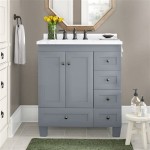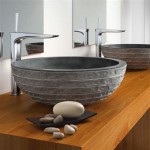Build Your Own Bathroom Vanity Top With Sink
A custom-built bathroom vanity top offers homeowners the opportunity to personalize their space and potentially save money. This project requires careful planning and execution, but the results can be highly rewarding. This article will guide readers through the process of building a bathroom vanity top with an integrated sink.
Planning and Material Selection
The first step is determining the vanity's dimensions. Accurate measurements of the existing vanity cabinet or the planned space are crucial. Consider factors like the desired overhang and the location of plumbing fixtures. Once dimensions are established, selecting appropriate materials is the next step.
Popular materials for vanity tops include natural stone (granite, marble, quartz), solid surface materials, and concrete. Each material has its advantages and disadvantages regarding cost, durability, and aesthetics. Natural stone offers a luxurious look but requires sealing and can be prone to chipping. Solid surface materials are less expensive and offer a wide variety of colors and patterns, while concrete provides a modern, industrial aesthetic but requires specific mixing and curing techniques.
Choosing the Right Sink
The sink selection plays a vital role in the overall design. Common options include undermount sinks, vessel sinks, and drop-in sinks. An undermount sink attaches to the underside of the countertop, creating a seamless look and easier cleaning. Vessel sinks sit on top of the counter, making a bold statement. Drop-in sinks are inserted into a pre-cut hole in the countertop, offering a classic and straightforward installation.
The chosen sink type will influence the construction process, particularly the cutting and finishing of the countertop material. Ensure the sink's dimensions are compatible with the planned vanity top size and leave enough space around the basin for comfortable use.
Required Tools and Equipment
Gathering the necessary tools and equipment before beginning the project ensures a smooth and efficient process. The specific tools required will depend on the chosen countertop material. However, some common tools include:
- Safety glasses and dust mask
- Tape measure and pencil
- Level
- Circular saw with a diamond blade (for stone or tile)
- Jigsaw (for intricate cuts)
- Drill with appropriate bits
- Router (for shaping edges)
- Caulk gun
- Clamps
- Sandpaper and polishing pads (for finishing)
Construction Process
The construction process will vary depending on the chosen materials and sink type. However, general steps apply to most projects. Begin by creating a template of the vanity top using plywood or cardboard. This template ensures accurate cutting of the countertop material. Carefully mark the sink cutout on the template.
Transfer the template to the countertop material and use the appropriate cutting tools to create the desired shape and sink cutout. For stone or tile, a wet saw with a diamond blade is recommended to minimize dust and chipping. Test-fit the sink in the cutout to ensure a proper fit.
Finishing and Installation
Once the countertop is cut and the sink fits correctly, the edges can be finished. Routing and sanding create a smooth and polished edge. For natural stone, sealing the countertop protects it from stains and water damage. Follow the manufacturer's recommendations for sealing and curing times.
Apply a bead of silicone caulk around the sink cutout to create a watertight seal. Carefully lower the sink into the cutout and secure it according to the manufacturer's instructions. Connect the plumbing fixtures and allow the caulk to cure completely before using the sink.
Considerations for Different Materials
Working with different materials requires specific considerations. Natural stone can be heavy and brittle, requiring specialized tools and careful handling. Concrete requires proper mixing and curing to achieve the desired strength and durability. Solid surface materials are generally easier to work with but may require specific adhesives and finishing techniques.
Researching the specific properties and installation requirements of the chosen material is crucial for a successful outcome. Consulting with experienced professionals or referring to detailed tutorials can provide valuable guidance.
Safety Precautions
Throughout the entire process, prioritizing safety is paramount. Always wear appropriate safety gear, including safety glasses and a dust mask, especially when cutting or sanding materials. Follow the manufacturer’s instructions for all tools and materials. Ensure adequate ventilation in the workspace when working with adhesives or sealants.
Building a bathroom vanity top with a sink can be a challenging yet rewarding project. By carefully planning, selecting appropriate materials, and following proper construction techniques, homeowners can create a custom vanity that perfectly complements their bathroom space.

Diy Vanity Tops For Your Bathroom

How To Build Protect A Wood Vanity Top Houseful Of Handmade
:strip_icc()/102130266-3174ac7d31314c7abfc80a1b65a11dd6.jpg?strip=all)
18 Luxurious Bathroom Countertop Ideas For All Budgets

Build Your Own Bathroom Vanity Fine Homebuilding

How To Build A Diy Modern Floating Vanity Or Tv Console

Diy Butcher Block Vanity Beneath My Heart

How To Build Protect A Wood Vanity Top Houseful Of Handmade

A Natural Treat Live Edge Vanity Top Redefines Modern Bathrooms Decoist

Diy Wood Vanity In The Master Bathroom Space Between

Diy Bathroom Vanity 12 Rehabs Bob Vila
Related Posts







